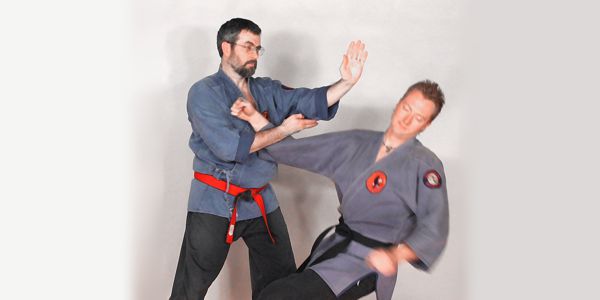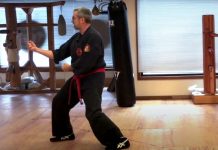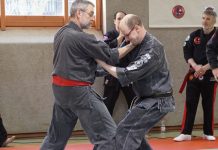I recently was explaining our concepts to a man who had been training at a local martial arts school. It was almost as if the last 20 years never happened – as if the martial arts community had never heard of any of the things we teach. So, let me give you a way to explain and talk about one of the most basic aspects of our teaching – it’s not a block!
In the usual training programs, there are a set of movements called “blocks.” These are up block, inside block, outside block, down block, and knife hand block. Let’s consider outside block (though, what I will say, applies to all of the blocks).
Outside block consists of two actions. In the first action, the front hand moves across the body at about hip level. This is sometimes referred to as the set position. Then the front hand moves outward to the side. This action is considered the block proper, and is taught as a way of knocking a punch passed the body.
Now, our premise is simple – this is not a block, and cannot be used as a block. Here’s how you can tell. Listen to the sound of a punch (fump). Now, listen to the sound a an outside block (fa-fump). If you think of this in musical terms, in terms of rhythm, a punch has one beat, an outside block has two beats. Now, considering that the act of blocking is a response to an attack, reaction time is also a factor, an added beat. In essence, then, using an outside block to block a punch means that you are using a two beat action (three beats if you consider reaction time) to defend against a one-beat attack. This means that you have to be more than twice as fast as your opponent. And that means that only the youngest, fastest, strongest can ever hope to use their karate. And that means that karate is all but useless for anyone else.
Now, let’s imagine that somehow I manage to use outside block to block a punch – What have I accomplished? Nothing. At best I have reset the encounter to the beginning. What happens next depends on who is faster. If the attacker is faster with his follow-up, I lose; if I am faster with my counter-attack, I win. But this means that the stronger, faster one wins, and that means that I can only use my karate if I am the better athlete in the encounter.
However, it turns out that outside block isn’t “outside block” at all. In Japanese it is called chudan yoko uke. Uke doesn’t mean “to block”, it means “to receive”. It is a way of dealing with an attack, to be sure. But, it is not a block. In fact, it has actually been painful for me to call these things blocks in what I have written so far. I always use the term “counter” as the English meaning of uke. I say, up counter, or down counter, but never block. Block is a banned word in my martial art.
The typical application for chudan yoko uke, is to use the movement of the”set” (the first-beat of the technique which corresponds to the one-beat of the punch) to actually strike the incoming arm. The outward movement is then a strike, typically to a vulnerable target on the head.
I have been following this concept for many years now. The longer I practice these techniques in the manner they were intended, the more I realize how genuinely intelligent and effective they are as fighting techniques. But this understanding comes only from realizing THEY’RE NOT BLOCKS! Blocks in Martial Arts are Strikes!
Thanks for reading,
Now, go train.
Chris Thomas











